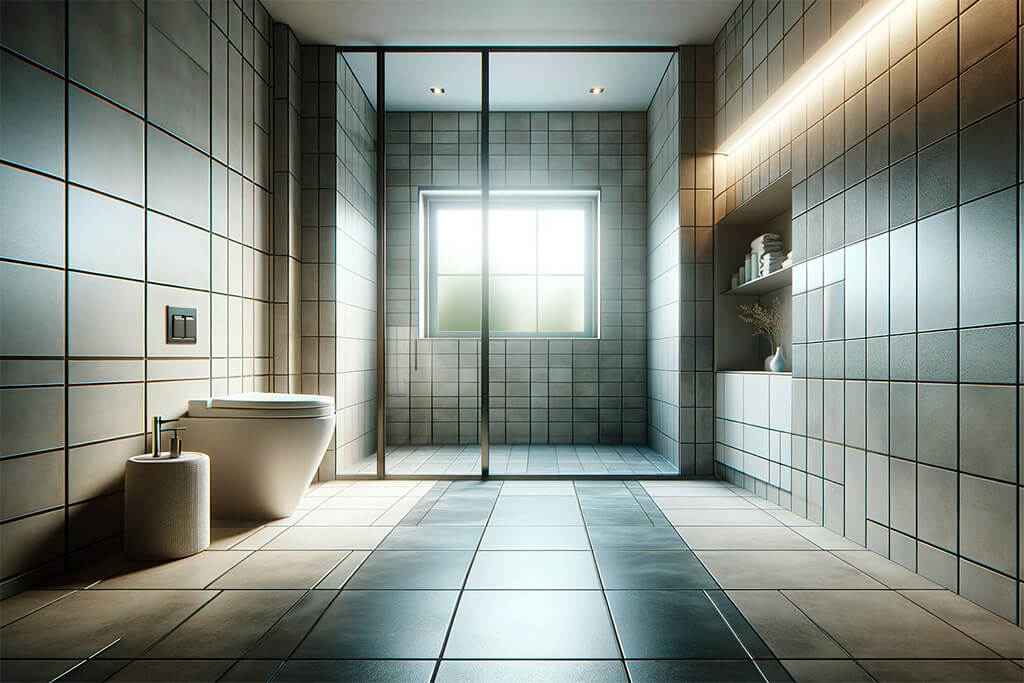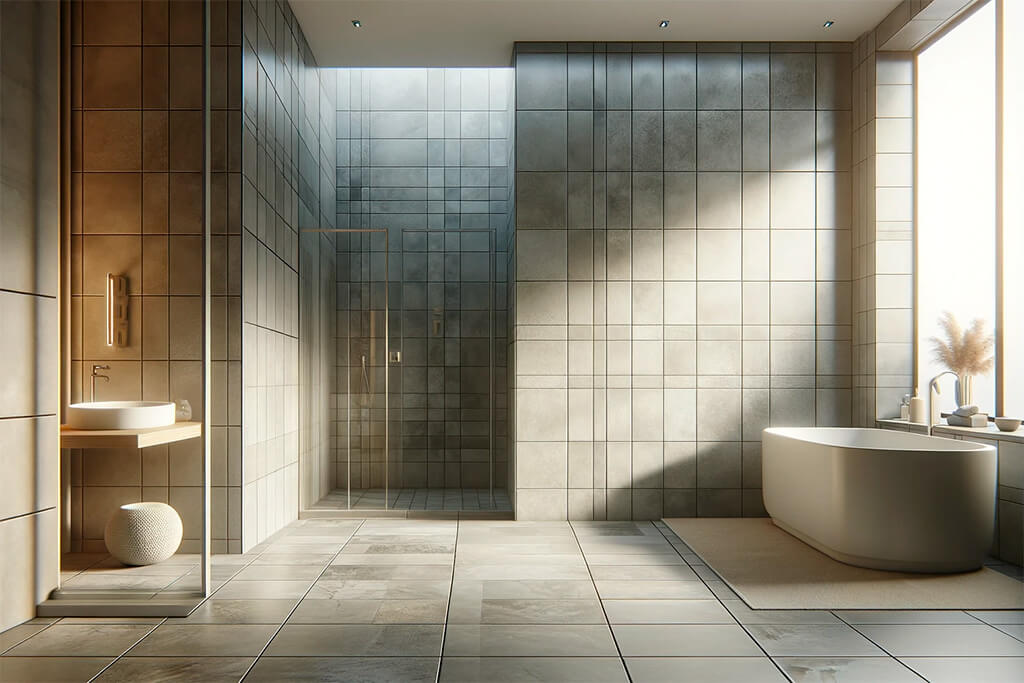When you’re knee-deep in a renovation project, the choice of materials can make or break your design. Ceramic tiles are a staple in this arena for good reason. Their durability and aesthetic versatility make them ideal for both floors and walls in various settings. Let’s delve into the journey of ceramic tiles from raw clay to the polished pieces we admire in our homes.

A Quick Dive into the History of Ceramic Tiles
Ceramic tiles aren’t a modern invention, they have graced the floors and walls of structures for millennia. Originating in ancient civilizations and refined over centuries, the production of ceramic tiles has evolved from an exclusive art form to a sophisticated, large-scale manufacturing process. This evolution mirrors the growth of our own skills in construction and design.
The Nuts and Bolts of Ceramic Tile Manufacturing
The essence of ceramic tile production lies in its raw materials – primarily a variety of clays mixed with minerals like silica and feldspar. Each component is meticulously selected to ensure the right consistency, color, and firing properties. These aren’t arbitrary choices, they’re grounded in a deep understanding of materials and their behaviors under different conditions.
Step-by-Step: Crafting Tiles from Scratch
- Preparing the Raw Materials: Precision is key here. The raw materials are not only mixed but also ground and sifted to achieve a uniform composition. This ensures that when the tiles are formed, they have consistent characteristics, an essential factor in quality control.
- Forming the Tiles: The methods used, such as pressing and extrusion, have their own technical nuances. Pressing, for instance, involves applying significant pressure to ensure density and uniformity, while extrusion allows for more intricate shapes and textures.
- Drying Them Out: This step is critical. The drying process stabilizes the tiles, removing moisture to prevent warping or cracking later. The precision of this phase can’t be overstated, even small deviations in moisture content can lead to significant issues in the final product.
- Adding the Glaze: Here’s where art meets science. Glazes not only add color and texture but also play a vital role in the tile’s durability. The chemical composition of the glaze, coupled with its firing temperature, determines the tile’s final appearance and resistance to wear.
- Firing Up the Kiln: Firing is a transformative process. It’s not just about reaching high temperatures, it’s about how the heat interacts with the clay and glaze. The right temperature and duration can make the difference between a tile that lasts a lifetime and one that disappoints.
- Sorting and Packaging: The final inspection ensures that only the best tiles make it to your local store. This step is about maintaining standards and ensuring that what you lay on your floor or wall meets the rigorous criteria set by the manufacturers.
In understanding the meticulous process behind the creation of ceramic tiles, we gain a greater appreciation for their role in our construction projects. This knowledge empowers us as builders and renovators to make informed decisions that impact the longevity and aesthetics of our work.
Technological Advances in Tile Manufacturing
In the realm of tile manufacturing, technological advancements have significantly enhanced both the quality and variety of tiles available. Automation has brought a level of precision to tile production that was previously unattainable, ensuring that each tile is consistently shaped and sized. This is crucial when you’re laying tiles and looking for a flawless finish. Environmentally, manufacturers have made strides in sustainability, increasingly incorporating recycled materials and reducing waste, which is not only good for the earth but also introduces eco-friendly options for your projects.
Types of Ceramic Tiles
Understanding the different types of ceramic tiles can greatly influence your choice depending on the project:
- Porcelain Tiles: Known for their durability, porcelain tiles are ideal for areas with high foot traffic or exposure to moisture. Their density and low porosity make them a reliable choice for bathrooms and kitchens.
- Glazed Ceramic Tiles: These tiles offer versatility in design with a wide range of colors and patterns available through the glazing process. They are perfect for adding visual interest to any room.
- Quarry Tiles: Renowned for their robustness, these unglazed tiles are suitable for outdoor spaces or areas requiring rugged materials.

DIY Tips: Choosing and Installing Ceramic Tiles
For those diving into a DIY tiling project, here are some essential tips:
- Selecting Tiles: It’s crucial to choose tiles that are appropriate for your specific application. Porcelain tiles are best for moist environments, while glazed ceramic tiles are easier to cut and handle.
- Installation Know-How: Accurate measurements and thorough surface preparation are key. A level surface ensures a smoother installation. When applying adhesive, it’s important to use the right amount – too little won’t hold the tile, and too much can create a mess.
Common Pitfalls to Avoid
- Avoid hurrying through the project. Careful planning and execution are vital.
- Allowing sufficient time for the adhesive to dry is crucial. Impatience can lead to tiles shifting or not adhering properly.
- Choosing the right grout color is as important as selecting the tile. Grout plays a significant role in the overall appearance of the tiled area.
Ceramic Tiles in Home Renovation
Ceramic tiles have become a key element in home design, offering both functionality and aesthetic appeal. The latest trends lean towards personalization, with tiles being used creatively in accent walls, backsplashes, and more. The advancements in tile manufacturing now provide a vast array of choices in colors, textures, and sizes, allowing for a high degree of customization in home renovation projects.
In essence, whether you’re a professional contractor or a DIY enthusiast, understanding the nuances of ceramic tiles can significantly elevate the quality of your renovation work. Each tile you lay is not just a part of the structure, it’s a testament to your craftsmanship and artistic vision.
Maintenance and Longevity of Ceramic Tiles
In the realm of tile maintenance, the mantra is simple: regular, gentle care. From my experience in construction and renovation, I’ve learned that maintaining ceramic tiles is as much about preventing damage as it is about regular cleaning. Using a pH-neutral cleaner prevents damage to both the tiles and the grout. When it comes to grout, a little attention with a soft brush and suitable cleaner can prevent discoloration and grime accumulation.
Be vigilant about cracks and chips. These small damages can escalate, leading to moisture problems and compromising the tile’s integrity. Promptly replacing a damaged tile can save you from more extensive repairs down the line.
Common Issues and Solutions in Ceramic Tile Maintenance
- Stains and Spills: Immediate action is crucial, especially for unglazed tiles. Consider using a penetrating sealer for better protection.
- Loose Tiles: This can indicate underlying issues, such as a deteriorating adhesive or subfloor problems. It’s essential to address the root cause rather than just reattaching the tile.
- Fading Colors: Prolonged exposure to sunlight can lead to fading. Using UV-protective sealants or appropriate window treatments can mitigate this issue.
FAQ Section
The key difference lies in their composition and manufacturing process. Porcelain tiles are made from a more refined clay and fired at higher temperatures, making them denser and more moisture-resistant. This makes them suitable for high-moisture areas like bathrooms. Ceramic tiles, while also durable, are better suited for interior walls and floors in lower-moisture areas.
The timeline for producing ceramic tiles varies based on the type and complexity. The process involves several stages, including mixing, forming, drying, glazing, and firing. Each stage must be carefully controlled and can take from several days to weeks.
Yes, ceramic tiles can be recycled, although not always into new tiles. They can be crushed for use in paving or as an aggregate in construction materials, contributing to sustainable building practices.
Certainly. The industry has seen a rise in tiles made from recycled materials and those produced using environmentally friendly methods. These options are not only sustainable but also offer a range of aesthetic choices.
